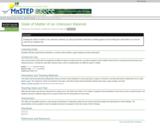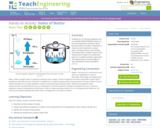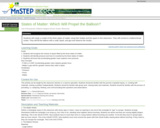
Watch a three-minute video about states of matter, sing karaoke about matter, learn vocabulary, and take a quiz.
- Subject:
- Mathematics
- Science
- Material Type:
- Interactive
- Provider:
- Scholastic
- Date Added:
- 12/01/2023

Watch a three-minute video about states of matter, sing karaoke about matter, learn vocabulary, and take a quiz.

In this video segment adapted from NOVA scienceNOW, learn about engineering innovations that could help detect a bridge's structural weaknesses before they become dangerous.

This video segment adapted from NOVA/FRONTLINE looks at American energy consumption and the resulting production of greenhouse gases.

This video segment, adapted from ZOOM, explores how sound waves travel differently through solids than through air, in this case, a metal clothes hanger.

This video segment, adapted from ZOOM, explores how sound waves travel differently through solids than through air, in this case, a metal clothes hanger. [1:14]

This activity is used to introduce the different properties of states of matter, by testing an unknown substance with household materials to determine which state of matter most closely resembles the material. It also can invole data collection, reasoning, grph making, and presentation of findings.

Students act as chemical engineers and use LEGO® MINDSTORMS® NXT robotics to record temperatures and learn about the three states of matter. Properties of matter can be measured in various ways, including volume, mass, density and temperature. Students measure the temperature of water in its solid state (ice) as it is melted and then evaporated.

This video segment from IdahoPTV's D4K explains and gives examples of the 4 states of matter: solid, liquid, gas, and plasma.

This activity is a lab investigation where students observe the four states of matter. At the end of the investigation students should be able to know that the differences among the physical states depend on the distance between the atoms or molecules and on the rate of movement of the atoms or molecules. And, that pressure and temperature control these two factors.

This activity models the states of matter and students investigate those states with a balloon/straw rocket.

Dr. Chris Muhlstein explains the challenge of studying materials that are too small to see with the naked eye. The technique some scientists use to observe individual atoms is similar to the technique of using touch to find out the size, shape, and location of objects in a small room. [1:05]

Electron orbitals. Diagonal rule. Dot diagrams. The periodic table. There's so much to know about the tiniest building blocks of life- atoms. [4:41]

What is everything made of? Thus far, we can break everything in the universe down to a few very small elementary particles. But they fit into strange patterns that are not understood. Clifford Johnson describes these ideas, along with the concept of string theory. [7:53]

Josh Kurz breaks macaroni salad down to its smallest chemical components. [3:14]

Watch the ZOOM cast discover which insulator -- newspaper or aluminum foil -- is better at keeping an ice cube frozen longer.

This interactive activity from the NOVA Web site challenges you to think like Einstein and understand how time travel might be possible.

Brookhaven National Laboratory delivers discovery science and transformative technology to power and secure America’s future. Operated by Brookhaven Science Associates for the U.S. Department of Energy’s Office of Science, Brookhaven Lab is a multidisciplinary laboratory with seven Nobel Prize-winning discoveries, 36 R&D 100 Awards, and more than 70 years of pioneering research.

This illustrated essay from the NOVA Web site answers questions about irregularities in the tides.

The life and philosophical treatises of Aristotle (384-322 BCE) are surveyed, including his writings on biology, zoology and physics.

How can you pick up an ice cube with a string? Watch this video segment adapted from ZOOM to see how salt can help.